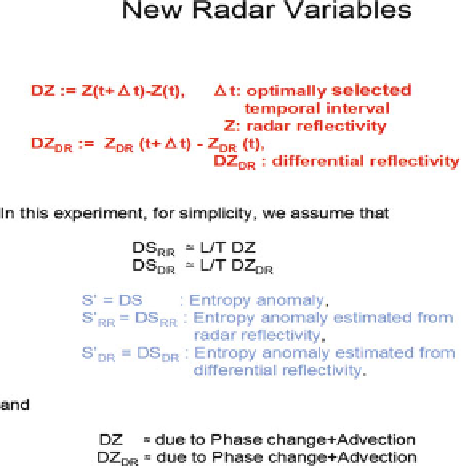Geoscience Reference
In-Depth Information
Fig. 18.16
New radar
variables
lower troposphere (
Sasaki 2009
) seems provide and answer to the question of why
the tornado is a low-level phenomenon.
The value of the heating or cooling, d'Q, may be estimated from the temporal
change of radar reflectivity, if the time step is taken small enough so that the
advection term of reflectivity becomes negligible. Other effects such as radiation
seem to be small compared against the latent heat. Because T is nearly constant,
240
273
ı
K for the condensation with super-saturation and evaporation processes
leads good estimates of dS from the latent heat release d'Q. It is the purpose of this
study to find a clue if we could estimate d'Q from radar reflectivity variations, in
spite of not detecting the details for the cause of d'Q. In order to get a feeling on the
order of magnitude estimate of flow velocity (rotational component)
v
, vorticity
-
!
in conjunction of d'Q and
S (from the distance between entropic source and sink
assuming linear profile of entropy) shown as a numerical example in Appendix 4.
The preliminary results of initial testing are shown in Sects.
18.11
and
18.12
in
addition to the comparison with VORTEX 2 (Sect.
18.9
). The new notations DZ,
DZ
DR
,S
0
,S
0
RR
,andS
0
DR
are defined as follows, and shown in Fig.
18.16
, because of
future use of the defined quantities:
r
DZ WD Z
.
t C dt
/
Z
.
t
/;
with optimally-selected temporal interval dt,
and radar reflectivity Z,
(18.40)
DZ
DR
WD Z
DR
.
t C dt
/
Z
DR
.
t
/
where Z
DR
is differential reflectivity,
(18.41)
S' W Entropy anomaly,
(18.42)

Search WWH ::

Custom Search